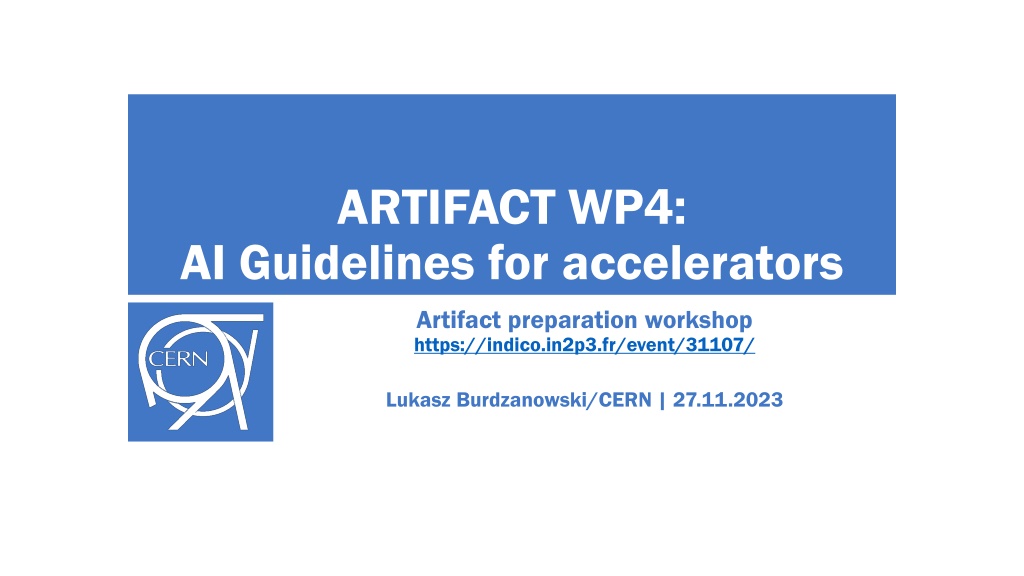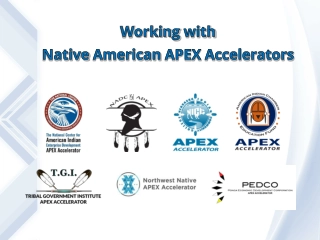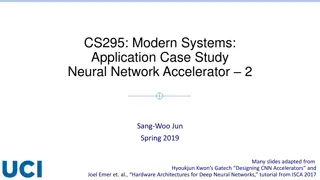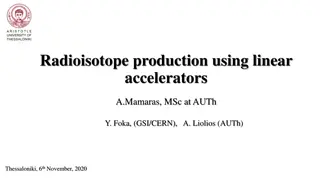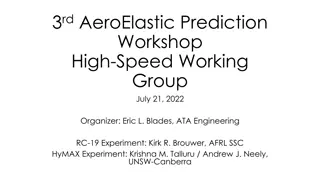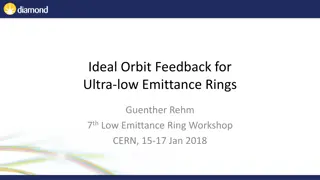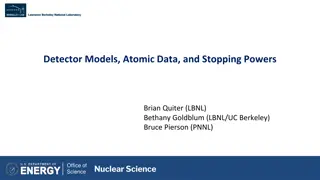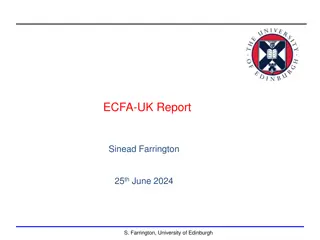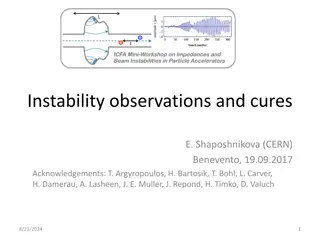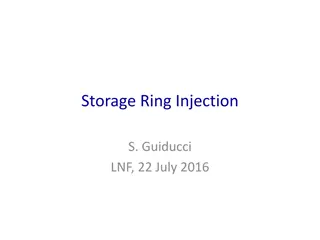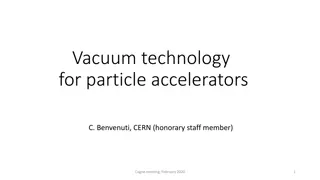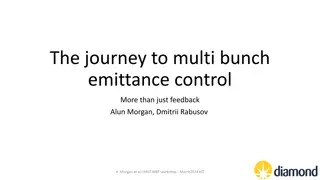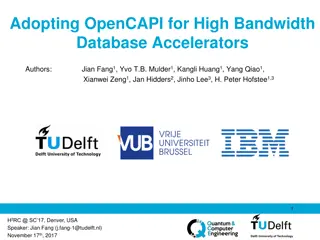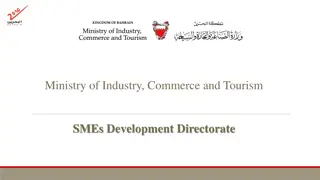AI Guidelines for Accelerators: Workshop Summary
Workshop summary on AI guidelines for accelerators focusing on achieving interoperability, leveraging AI solutions, and enabling accelerators to function as autonomous machines. The document contains principles and work breakdown for developing functional guidelines applicable to various domains beyond control systems. Collaborative process involving WP leads, partners, and industry experts to ensure applicability in modeling, simulation, and analysis.
Download Presentation

Please find below an Image/Link to download the presentation.
The content on the website is provided AS IS for your information and personal use only. It may not be sold, licensed, or shared on other websites without obtaining consent from the author.If you encounter any issues during the download, it is possible that the publisher has removed the file from their server.
You are allowed to download the files provided on this website for personal or commercial use, subject to the condition that they are used lawfully. All files are the property of their respective owners.
The content on the website is provided AS IS for your information and personal use only. It may not be sold, licensed, or shared on other websites without obtaining consent from the author.
E N D
Presentation Transcript
ARTIFACT WP4: AI Guidelines for accelerators Artifact preparation workshop https://indico.in2p3.fr/event/31107/ Lukasz Burdzanowski/CERN | 27.11.2023
Aspirational objectives for this WP Aspirational objectives for this WP Set forth high Set forth high- -level functional guidelines level functional guidelines that can be adapted to specific implementations, with a focus on achieving interoperability achieving interoperability. Respect and take into account the diverse nature Controls Systems and challenges across research institutes diverse nature of research institutes. Produce a document containing guidelines on how AI solutions can be leveraged can be leveraged in the accelerator Controls domain and beyond, with the aim of enabling accelerators to function as autonomous machines how AI solutions function as autonomous machines. AI solutions as the enabler of higher efficiency. AI solutions as the enabler of higher efficiency. ARTIFACT WP4: AI Guidelines for accelerators | Artifact preparation workshop | Lukasz Burdzanowski | 27.11.2023 2 2
The guidelines The guidelines the work principles the work principles The ensure applicability of the guidelines, following are the principles: Iterative and agile process Iterative and agile process, collaboration with all the WP leads and partners, as the source of functional requirements. WP5: AI ready accelerator data on the cloud WP5: AI ready accelerator data on the cloud WP6: AI algorithms in the accelerator context WP6: AI algorithms in the accelerator context Close collaboration with Control Systems* engineers from participating Control Systems* engineers from participating institutes institutes, as the means to validate technical concepts and limitations. Engagement with industry partners Engagement with industry partners, as the means to identify available solutions and benefit from established know-how. * Controls Systems * Controls Systems the guidelines should be applicable to domains beyond the Controls, such as modelling, simulation, analysis the guidelines should be applicable to domains beyond the Controls, such as modelling, simulation, analysis. . ARTIFACT WP4: AI Guidelines for accelerators | Artifact preparation workshop | Lukasz Burdzanowski | 27.11.2023 3 3
Work breakdown Work breakdown key items key items 1. 1. Identify AI boundaries and driving use Identify AI boundaries and driving use- -cases. Gather the requirements and establish shared understanding and considerations important for this work. The rules of these guidelines. 2. 2. Analyse and map accelerator Control Systems concepts. Analyse and map accelerator Control Systems concepts. Chart the relevant landscape of accelerator Controls Systems with its glossary, essential data formats, functional elements and business processes. Foundational analysis to leverage the AI. Foundational analysis to leverage the AI. 3. 3. Analyse and map AI techniques relevant to Control Systems. Analyse and map AI techniques relevant to Control Systems. Discuss the fit-for-purpose of how predictive maintenance, anomaly detection, adaptive control, HMI and other AI techniques can be applied. Chart the relevant AI landscape. Chart the relevant AI landscape. 4. 4. Conceptual design of AI enabled accelerators Controls System. Conceptual design of AI enabled accelerators Controls System. Propose a conceptual design maximising use of AI. Generic and aiming for interoperability and applicable to participating institutes and beyond. Make this work relevant to everyone. Make this work relevant to everyone. 5. 5. Define implementation scenarios for the guidelines. Define implementation scenarios for the guidelines. With the guidelines at hand, decide on how to publish, use, communicate and implement it. How to make use of it. cases. shared understanding of use-cases and boundaries. Identify the main principles The rules of these guidelines. How to make use of it. ARTIFACT WP4: AI Guidelines for accelerators | Artifact preparation workshop | Lukasz Burdzanowski | 27.11.2023 4 4
WP 4.1 Identify AI boundaries and driving use WP 4.1 Identify AI boundaries and driving use- -cases cases 1. 1. Gather input from related WPs regarding the needs and opportunities for AI applications Gather input from related WPs regarding the needs and opportunities for AI applications Collaboration with work packages leaders to better understand and validate any identified AI-related aspects, particularly: WP5: AI ready accelerator data on the cloud WP5: AI ready accelerator data on the cloud & WP6: AI algorithms in the accelerator context WP6: AI algorithms in the accelerator context Standardization principles Standardization principles Define means to standardize processes, procedures, or specifications which should be developed and applied, to ensure consistent and reliable application of AI consistent and reliable application of AI. Industry best practices Industry best practices Identify industry best practices in the domain of AI application for Control Systems, modeling and simulation, when possible engaging with experts in the field engaging with experts in the field. Compliance requirements Compliance requirements Identify the needs for regulations needs for regulations to assist the organizations in adhering to legal and regulatory requirements regulatory requirements, if any. Documentation principles Documentation principles Define how the documentation and record-keeping in relation to implementation and use of AI and ML should be done, particularly in terms of accountability, traceability, and auditing accountability, traceability, and auditing. Interoperability standards and needs Interoperability standards and needs Identify interoperability standards and needs to facilitate or ensure integration of Control Systems of Control Systems and their components in AI related aspects. Environmental considerations Environmental considerations Identify sustainability concerns and eco sustainability concerns and eco- -friendly practices important to the successful integration of AI and ML integration of AI and ML. Ethical considerations Ethical considerations Identify ethical concerns related to the application of AI solutions ethical concerns related to the application of AI solutions in the field of Control Systems for research institutes, e.g. Ethics guidelines for trustworthy AI . 2. 2. 3. 3. 4. 4. legal and 5. 5. 6. 6. facilitate or ensure integration 7. 7. friendly practices important to the successful 8. 8. ARTIFACT WP4: AI Guidelines for accelerators | Artifact preparation workshop | Lukasz Burdzanowski | 27.11.2023 5 5
WP 4.2 Analyse and map accelerator Control Systems concepts 1. Identify the glossary of Control Systems relevant terms. List of terms specific to control systems, reference document that clarifies the terminology used within the context of control system design, operation, and maintenance; establish a common understanding and promote effective establish a common understanding and promote effective communication communication. Identify and map functional elements of a generic accelerator Control System. Chart the key functional components, providing a systematic overview of its operational elements. Creating a structured representation that outlines how different components interact and collaborate in the context of an accelerator control outlines how different components interact and collaborate in the context of an accelerator control system system. Identify data formats required for an interoperable accelerator Control Systems. Recognize and specify the necessary data formats that facilitate seamless communication and interoperability establish the principles of a standardized approach to data representation. In close collaboration following the ready accelerator data on the cloud ready accelerator data on the cloud . Identify business processes relevant to the operation of a generic accelerator Control System. Recognize and highlight the key operational processes and workflows that are crucial for the effective functioning key operational processes and workflows that are crucial for the effective functioning of an accelerator control system. 2. 3. seamless communication and interoperability. Aim to close collaboration following the WP5: AI WP5: AI 4. ARTIFACT WP4: AI Guidelines for accelerators | Artifact preparation workshop | Lukasz Burdzanowski | 27.11.2023 6 6
WP 4.3 Analyse and map AI techniques relevant to Control Systems 1. Predictive maintenance and Anomaly or Fault detection Analyse the means to apply AI driven solutions to lower the control system downtimes means to apply AI driven solutions to lower the control system downtimes due to unexpected failures, including hardware and software. Optimization and Adaptive Control Analyse the means to leverage AI solutions to improve energy efficiency and overall system performanc leverage AI solutions to improve energy efficiency and overall system performance when applied to the Controls. Process automation and Optimization Analyse the opportunities to automate decision-making processes, reducing the need for manual intervention allowing systems to respond to changing conditions. Pattern recognition, Data analysis and Insights Define means to employ AI to identify complex patterns and correlations in data, the analysis of historical and real-time data to provide insights impacting the decision provide insights impacting the decision- -making making. Human-Machine interaction. Analyse the role of AI-powered interfaces which can understand and respond to natural language queries understand and respond to natural language queries, enhancing communication and interaction between users and the system. 2. 3. reducing the need for manual intervention and 4. 5. ARTIFACT WP4: AI Guidelines for accelerators | Artifact preparation workshop | Lukasz Burdzanowski | 27.11.2023 7 7
WP 4.4 Conceptual design of AI enabled accelerators Controls System 1. Define fit for purpose of AI solutions in function of mapped Control Systems elements and processes. Determine the suitability and effectiveness of AI technologies in addressing specific needs suitability and effectiveness of AI technologies in addressing specific needs and challenges within the context of control systems. Define system architecture of accelerators control system based on AI solutions. Outline the structural framework and the design of an accelerator control system that integrates and leverages artificial intelligence solutions. Specify how AI components how AI components, such as machine learning algorithms or intelligent decision-making systems, are incorporated into the overall architecture to enhance the control, efficiency, and adaptability are incorporated into the overall architecture to enhance the control, efficiency, and adaptability of the accelerator system. Engage with pilot projects from TEX and CLARA to validate developed concepts. Actively follow-up the pilot implementations of AI solutions in TEX and CLARA to validate the developed principles, concepts and guidelines concepts and guidelines. Inject the findings into the guidelines Inject the findings into the guidelines. 2. 3. validate the developed principles, ARTIFACT WP4: AI Guidelines for accelerators | Artifact preparation workshop | Lukasz Burdzanowski | 27.11.2023 8 8
WP 4.5 Define implementation scenarios for the guidelines 1. Define the modality of publishing and hosting the document. Determine the method or platform to make the document accessible, terms of access. Follow the EU principles and recommendations recommendations. Follow the EU principles and 2. Define how the guidelines should be used, realized, communicated and implemented. Establish a clear set of instructions and strategies for the application and execution of the guidelines clear set of instructions and strategies for the application and execution of the guidelines. Specify the intended audience, outline the steps for implementation, detail communication methods for dissemination, and provide guidance on how to utilize and integrate the guidelines into respective institutes, processes or systems. ARTIFACT WP4: AI Guidelines for accelerators | Artifact preparation workshop | Lukasz Burdzanowski | 27.11.2023 9 9
Conclusions Conclusions The close collaboration among relevant work packages is crucial to the success of this work package. We need to be driven by tangible needs. We need to be driven by tangible needs. The WP4 is an opportunity to combine the practical engineering experience with combine the practical engineering experience with analysis analysis of how to employ AI to make systems more efficient. The important questions, to which the guidelines can help to answer are: What are our sustainability concerns? Should we invest into Explainable AI? What is the ethical use of Machine Learning and AI? What are the guardrails to protect the person that s the subject of the AI? ARTIFACT WP4: AI Guidelines for accelerators | Artifact preparation workshop | Lukasz Burdzanowski | 27.11.2023 10 10
